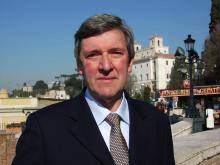Some 250 bishops from all over the world will gather in synod in the Vatican from Oct. 4 to 25 for what many consider to be the most important assembly of this kind since the Second Vatican Council. They gather exactly 50 years after that council to focus on the family and, in the words of Pope Francis at the end of the 2014 synod, “to find concrete solutions to so many difficulties and innumerable challenges that families must confront; to give answers to the many discouragements that surround and suffocate families.”
This synod has raised great expectations on the one side and many fears on the other such as we have not seen since Vatican II. Cardinals, bishops and lay commentators have expressed their hopes or fears in books, articles and interviews over the past two years, and this has revealed both the recognition of the importance of the synod and the existence of a divide among them—also evident in the 2014 synod—that can be presented as two camps.
For one camp, the primary pastoral responsibility is to convey with unwavering fidelity the doctrinal articulation of Catholic faith regarding marriage, in the full recognition that this risks alienating many from the life of the church. Advocates of this perspective view two dangers from a failure in this pastoral responsibility. The first is that it would probably send the message, to young people in particular, that patterns of life that reject key elements of the Catholic marriage are morally acceptable and can be mainstreamed into the life of the family and the church. The second, perhaps graver danger, is that of an erosion in the content and integrity of the Catholic theology of marriage. Those who belong to this camp believe that Catholic teaching on sexuality and marriage is an integrated whole, philosophically, theologically and pastorally. It cannot be shaved at the margins to attain pastoral objectives without sacrificing its structure and integrity.
The opposing camp views this approach as imprisoning the pastoral outreach of the church within such narrow limits that it is cut off from the realities of marriage and family life as they exist in the world today. They view the primary pastoral challenge of the church on issues of marriage and family life as the call to offer real accompaniment to men and women as they confront the central decisions of their lives.
This can only be effective if it includes an embrace of the good and grace-filled elements of life choices that men and women are making, even when those choices are embedded in actions and relationships that do not conform to major elements of the church’s theological and philosophical vision. Accompaniment is not reconcilable with a doctrinally oriented suspicion that can see only the gap between the lived reality and the church’s vision, without acknowledging profoundly the goodness of heart and will and action that are already present.
This divide is not merely a part of the discussion of the coming synod. In its essence, it encapsulates the choice that confronts the church in every facet of its teaching and pastoral outreach at this time in history. That fundamental choice can be framed as follows: Should the church concentrate more on pointing to the gap between the Catholic moral vision and the lived reality of people in the modern world, or should it concentrate more on walking with men and women precisely in their lived reality, accompanying them and pointing to the moments of grace already present in their lives as the foundation for moving toward the Christian ideal?
The synod’s answer to this question, through the solutions it comes up with, could have far-reaching implications for how the church will to carry out its mission in the 21st century.
Looking ahead to the synod, Francis reminded new cardinals on Feb. 15 that throughout the church’s history “two ways of thinking are present: casting off and reinstating.” There is “the thinking of the doctors of the law, which would remove the danger by casting out the diseased person, and the thinking of God, who in his mercy embraces and accepts by reinstating him.” From the time of the Council of Jerusalem, he stated, “the church’s way has always been the way of Jesus, the way of mercy and reinstatement.”








